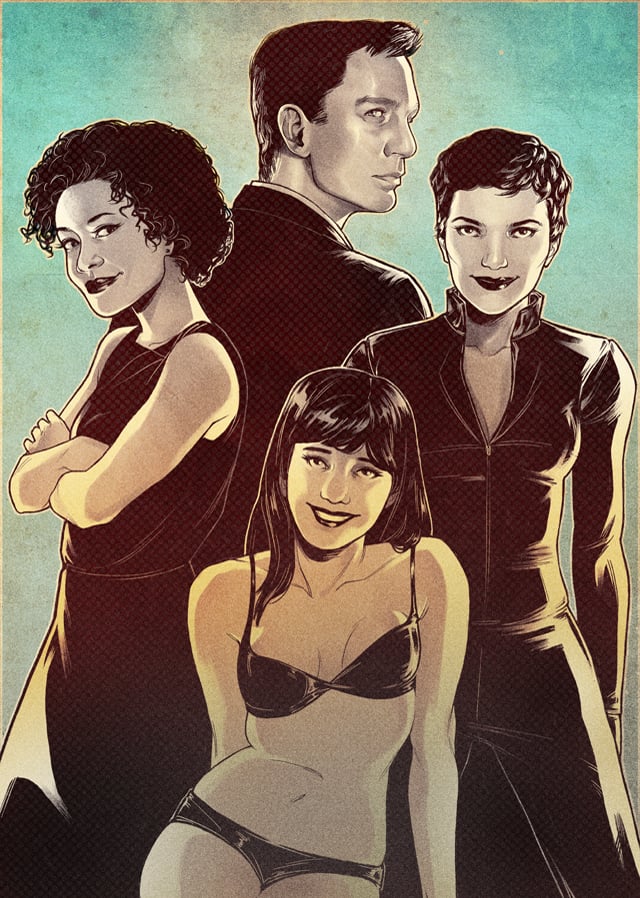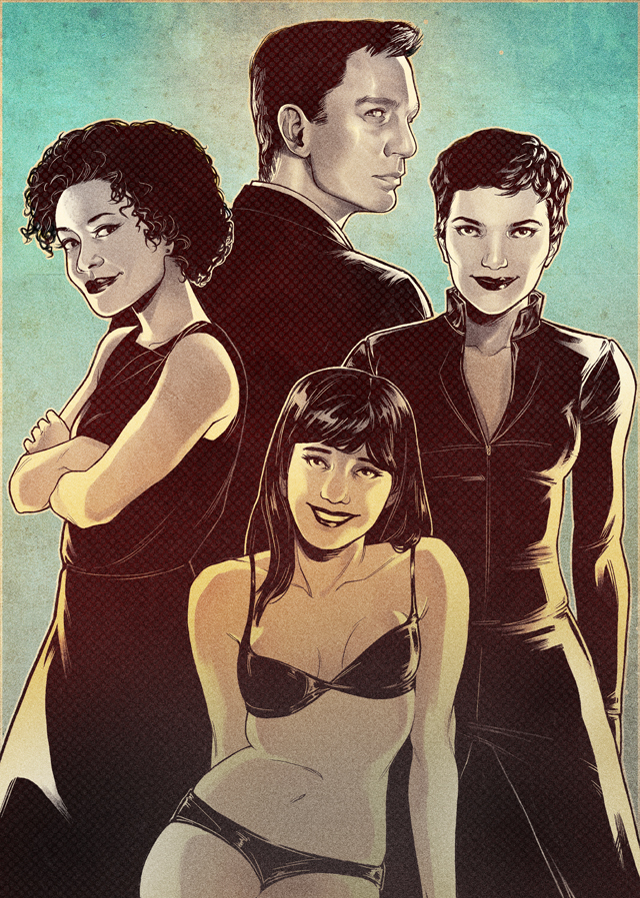
Original illustration by Emilie Majarian for The Mary Sue.
Welcome to Bond Girl, a new series where we’ll be re-watching and re-evaluating every James Bond film until Spectre’s release. Check out previous entries here.
Content warning for mentions of racism, offscreen/pre-film child death, fridging.
I get why some people (including the producers of the franchise) don’t like George Lazenby as James Bond. He has pretty huge, Sean Connery-sized shoes to fill, while being nothing like the man’s Bond. And Lazenby’s acting can be over the top, like he’s trying too hard at times to be Connery’s Bond instead of his own, but he makes it work. More than that, in On Her Majesty’s Secret Service, Lazenby manages to humanize James Bond and make him a character worth empathizing with. Aside from a few incidences of violence towards women and racism, I found a lot to like about the film and Lazenby’s Bond.
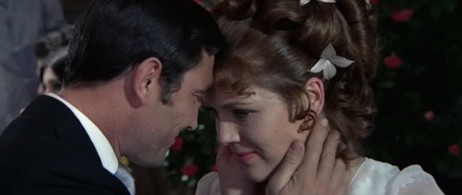
On Her Majesty’s Secret Service is the sixth film in Eon Production’s James Bond series and it’s based on the novel of the same name. The plot of the film revolves around recurring SPECTRE head Ernst Stavro Blofeld and his plan to hold the world food supply hostage if he doesn’t get amnesty for his crimes. The subplot – my favorite subplot so far — focuses on Bond’s relationship with Contessa Tracy de Vicenzo. This film follows closely along with the book and has a realistic style that, like the book, focuses on a more human side of James Bond.
On Her Majesty’s Secret Service isn’t slotted into book order. Technically, it comes before the previous movie in the series. The events in You Only Live Twice come as a direct result of what happens at the end of this film. Watching the films in chronological order (at least the early ones) really messes up the way you look at the plot.
Unless, of course, you’re like me, and your favorite James Bond/007 theory is the one about how the name and title goes to different men throughout the ages, thus creating a legend of this immortal spy who can’t be killed. The actor changes (from Connery to Lazenby) and the nods to it in the canon with Lazenby actually complaining how “this never happened to the other fellow” actually make the theory plausible. There’s also a scene with Bond cleaning out the desk he rarely uses (as he’s often out in the field) and picking up gadgets or keepsakes, while the background music shifts to that of previous movies.
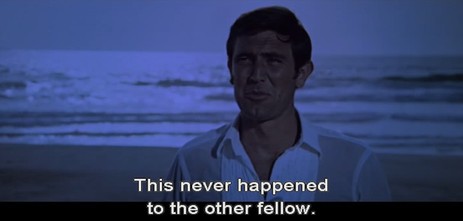
Looking at this film as another 007 taking over the role from Connery’s Bond helps to smooth away the rough and weird edges of the film and the places that just don’t make sense. Definitely, this whole headcanon was the main thing that kept me from constantly focusing on the holes in the plot. (Seriously, the biggest hole was how Blofeld and Bond didn’t recognize each other despite their interaction in the previous film.) I get that they produced the films in a certain order, and that they probably had reasons for it, but the little weird mismatches in this film were irritating.
I do like how Lazenby’s lone outing into the Bond franchise is this weird mix of trying to recapture Sean Connery’s characterization while also just going out in to left field. Lazenby’s Bond is a lot like Connery’s Bond in several ways: he’s a womanizer and doesn’t care who knows it; he’s well dressed and sharp eyed; he’s attractive and women come to him because he’s charming (in fact, aside from Tracy’s scenes, he’s not really the aggressor in most of the romantic scenes in this film!).
He even reads an issue of Playboy magazine and gets a little handsy with Moneypenny in what definitely isn’t his best moment in the film. Overall, it’s a bit over-the-top, but not entirely in a good way. For much of it, Lazenby is following Fleming and Connery’s examples. So while I’m annoyed, it’s not a new issue with Lazenby’s Bond, but part of my continued annoyance at the franchise.
Despite the glaring similarities in character flaws, however, Lazenby’s Bond wins a point from me in one aspect: On Her Majesty’s Secret Service was the first Bond novel (and film) to focus on James Bond’s emotions on any significant level. Most of the time, James Bond is this aloof figure that kills, quips, and moves on without thinking about what he’s doing or how it affects other people. For this film at least, James Bond is slightly more emotional. His relationship with the countess Tracy is incredibly well played out, and the very end of the film left me sniffling and wiping away tears. I am sensitive to a fault, and I know that, but for a relatively inexperienced actor, Lazenby excelled at showing a sensitive side to our favorite agent.
More than that, Lazenby was believable. Sean Connery’s a good actor, but I’m going to be frank: I don’t really think that I would believe any honest emotion from his Bond that didn’t have to do with desire. Because Lazenby is new to the role, you can read his Bond differently, and there’s really no need to suspend disbelief about the sincerity of his relationship with Tracy or, at the end of the film, his grief and shock at her death.
Now, I can’t mention Tracy’s death without talking about her character. As always, I’m watching James Bond films for the women. James Bond is a cool character (if a little hard to understand in the earlier films) but the women around him are way more interesting to me, in part because they’re allowed to show emotion besides scathing sarcasm or lust.

While there is a large cast of women in On Her Majesty’s Secret Service, the female character that stands out to me the most is Contessa Tracy de Vicenzo. Tracy is the daughter of a wealthy and well-connected criminal and we first see her trying to commit suicide by walking into the sea. We don’t know why she’s doing it, because, before Bond gets a chance to ask, he winds up in a fight with some men on the beach.
Tracy turns out to be one of the most fleshed out characters in the film. Despite the fact that much of the exposition about her backstory comes from her dad (who is, in turns, overbearing and endearing), it’s the best backstory in the whole film, and certainly the best Bond Girl backstory so far in the franchise. After the death of her mother and her father’s failure to understand her, Tracy experiences a rebellion. She acts out, and even winds up marrying someone that inevitably disappoints her and dies; however, we find out that the event that hurt the most was the death of her child. That’s more than we know about most characters in the Bond franchise, including the man himself.
I’m going to be honest, while she has never been an immediate favorite character the way that Moneypenny has been throughout the years, Tracy is definitely in my top fifteen Bond girls. I liked that she was definitely going through trauma that wasn’t related to Bond, and that she was happy with him. Tracy didn’t see herself with Bond at first, and she was cool towards him – and yet it wasn’t sex that changed her mind towards him, but conversation (which is novel, because she’s still intimate with Bond, but it’s all on her terms).
And then of course, she winds up dying before she and James Bond can even go on their honeymoon. Shot to death by SPECTRE henchwoman Irma Bunt, Tracy dies before Bond can even take her into his arms. (Seriously, the scene is heartbreaking. Go watch it and feel sad.)
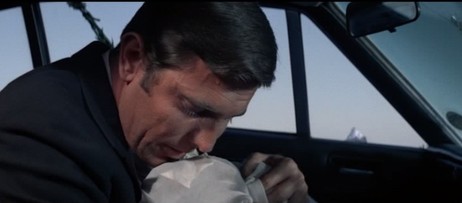
In the novels, Tracy Bond’s death is the catalyst for You Only Live Twice and Bond’s hunt for Blofeld. It’s also a catalyst for James Bond’s kind of breaking. When I say textbook fridging, this is it. This is so it. Tracy Bond is killed because it will break James Bond and send him off on a wild hunt for the man who took his wife away.
How uncool is that?
We have a fabulous character in Tracy Bond and she doesn’t even make it to the end credits. All of this to make sure that Bond has a legitimate reason to hunt down Blofeld and SPECTRE (because doing his job isn’t motivation enough apparently). This is one of my biggest issues with the movie and with the books, because Tracy is killed off to fan the flames of Bond’s manpain and then she’s barely mentioned at all for the rest of the series.
Ugh.
Aside from the constant sexism and the whole fridging thing, there weren’t many things that I outright hated.
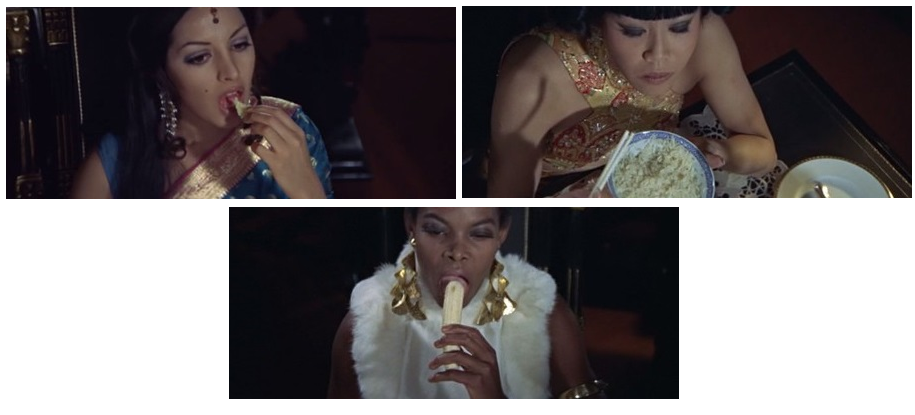
One aspect of the movie, though, made me question my perceptions and whether I was seeing racism where there was none. About halfway through the film there’s a scene where all of the “patients” at Blofeld’s clinic are seated at dinner with plates in front of him. The young women are from all over the world and the plates represent that. It should be a charmingly multicultural scene where we see all of the young women representing their home countries. It kind of isn’t. At least it wasn’t to me. Why?
Because of a few examples of what the women were eating. The young woman from India was eating naan. The Chinese patient was eating a bowl of rice. And here’s the kicker: the young woman from Africa was straight up eating a banana.
Now, I was immediately like, “wait, this is kind of racist,” and was prepared to side-eye the heck out of the production. My older sister (who occasionally sits down with me to make fun of the films) had the opposite reaction. She thought that the scene was weird (and that the banana thing was one small part of a very sexual scene), but she didn’t read it as racism. That actually threw me for a loop, because here I was, convinced that I was seeing something incredibly racist, only for the only other person in the room with me to say otherwise.
Who’s right in this case? Who’s wrong? Who knows. The scene is a mess from start to finish so it’s not winning any awards from me, but the little quibble of perception makes me think. I’m watching these films as an adult whose academic career has been focused on social justice and issues of identity. Right now, I’m largely seeing the things that are wrong with the series and sometimes have to work to remember that yes, I really do still love James Bond as a character and as a franchise. However, that doesn’t mean that I’m right all the time about what I’m perceiving, and I am really interested in finding out whether or not other James Bond fans are getting the same read as I am.
I still like Lazenby’s Bond, despite all that. I love that I could sit there and compare things like fighting styles and interpersonal skills between Lazenby’s performance and Connery’s all day.
Did I enjoy the film more since I didn’t build it up like I did with the 1967 Casino Royale? Actually… yes I did. I didn’t have as many expectations for the film aside from the change in actors, and I was pleasantly surprised by the hands-on fight scenes and the lack of gadgets. Sure, it’s not likely to make my top ten list of Bond films, but it’s a good film, and I found myself wondering just what the franchise would’ve been like had Lazenby continued on for a few more movies.
What I’m looking forward to:
Next week you all will get to read my gushing post about Diamonds are Forever, but seriously, that movie is my ultimate problematic fave as far as Connery’s Bond films go. I love all of that movie and am utterly obnoxious about bursting into the theme song at the worst possible moments as I do my rewatches during the week. This is Sean Connery’s last Bond film with Eon, and I’m looking forward to sending him off right!
Stitch writes about comics, nerd history, and ridiculous romance novels when not working frantically on her first collection of short stories. Find her on her blog or on Twitter.
—Please make note of The Mary Sue’s general comment policy.—
Do you follow The Mary Sue on Twitter, Facebook, Tumblr, Pinterest, & Google +?



